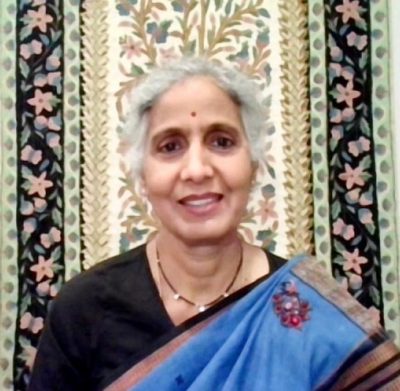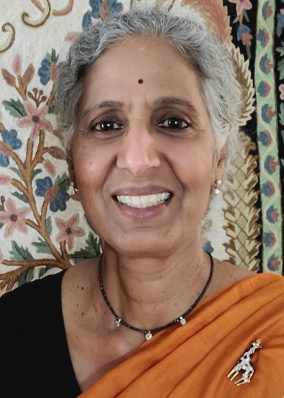
Carnatic Compositions – The Essence and Embodiment
–Aparna Munukutla Gunupudi
Our intent for this essay is to highlight the great features of the language, emotion and melody (rAgam) of a krithi (song/composition) and also to provide the song for your listening pleasure. Most of you may know these krithis, but when you discover the distinct features of a krithi, you may enjoy a new beauty or an attribute in the krithi.
Note: Krithi is defined as a song containing pallavi, anupallavi and charanam that have high musical value and can be sung elaborately with improvisations. Whereas, Keerthana also has a pallavi, anupallavi and charanam but is sung in a single form or simpler pattern.
Krithi: mAmava PaTTAbhi rAma
rAgam: MaNirangu
tAlam: Misra chApu
Lyrics: Muttuswami Deekshitar
Language: Sanskrit
Pallavi
mAmava paTTAbhirAma jaya mAruti sannuta nAma (rAma)
anupallavi
kOmalatara pallava pada kOdanDa rAma ghana-
syAmala vigrahAbJa nayana sampUrNakAma
raghurAma kalyANarAma rAma
caraNam
chatra chAmara karadhruta bharata lakshmaNa
satrughna vibheeshaNa sugrIva pramukhAdi sEvita
atri vasishTAdyanugraha pAtra dasaratha
putra maNirangavallyAlankruta nava-
ratna maNTapE vichitra maNimaya simhAsanE
seetayA saha samsthita sucharitra parama pa-
vitra guruguha mitra pankajamitra vamsa-
sudhAmbudhi chandra mEdinIpAla rAmachandra
Meaning:
mAmava paTTAbhirAma – Oh crowned rAma, protect me
Jaya – victory
mAruti – Anjaneya, son of marut, wind god
Sannuta – praised
nAma – name
kOmalatara – with very delicate
pallava pada – feet
kOdanDa rAma – rAma with the kodanDa bow
ghana syAmala vigraha – deep dark bodied
abJa nayana – lotus petaled eyes
sampUrNakAma – fulfills every wish completely
raghurAma – RaghurAma
kalyANarAma – KalyAna rAma
rAma – rAma
Chatra – umbrella/awning
chAmara – fan
Karadhruta – held in their hands
Bharata – Bharata
lakshmaNa – lakshmaNa
Satrughna – satrughna
vibheeshaNa – vibheeshaNa
sugreeva – sugreeva
pramukhAdi – other dignitaries
sEvita – serving
Atri – sage Atri
vasishTyadi – sage VasishTa and others
anugraha pAtra – obtaining their blessings
dasaratha putra – son of dasaratha
maNi – gems
rangavalli – an artistic pattern on the floor
alankruta – decorated
navaratna maNTapE – in a hall studded with nine gems
vichitra maNimaya – studded with variety of gems
simhAsanE – the throne
seetayA saha – together with Seeta
samsthita – seated
sucharitra – well reputed
parama pavitra – very pious/righteous
guruguha mitra – a friend of guruguha
pankajamitra vamsa – family of the friend of lotuses (the Sun) or Sun dynasty
sudhAmbudhi chandra – like a moon shining from that milky ocean
mEdinIpAla – the ruler of the land
rAmachandra – rAma chandra
Deekshitar portrayed the perfect picture of Sri Rama’s Pattabhishekam in this kruthi. He starts by calling him delightfully as Pattabhirama (crowned Rama), a name that is always praised by Anjaneya. He later describes him as a person with delicate feet, holding a kodanda bow, dark complexioned strong bodied, with eyes like lotus petals, one who fulfills every wish, praises as Raghurama, Kalyanarama and Rama. The charanam offers the most beautiful scene in front of you. Ramachandra, the son of Dasaratha, reputed, radiant (like a moon), and righteous one in the Sun dynasty, is attended by his brothers Bharata, LakshmaNa and Satrughna holding an umbrella/parasol, fanning him on both sides, is followed by Vibheeshana and Sugreeva, while sages Atri, VasishTa and others showering the blessings, at the stage decorated with gems and beautiful patterns on the floor, seated together with Seetha on a gem studded throne under the canopy that is decorated with nine gems, is ready to rule the country.
You need to look no further to imagine the scene of Sri Rama’s pattbhishekam/coronation than listen to this melodious song. It is very apt that Deekshitar used the Manirangu ragam to mean color of gems, which fits with the setting of the coronation court with gems and colorful decorations. Not only does he set it in that ragam, but also he cleverly embeds the name of the ragam in the song. Sri Rama hails from a very famous dynasty (Ikshwauku/Solar dynasty) that is known for righteousness, justice and fairness. Sri Rama ruled his kingdom with fairness and justice for a number of years, performed several aswamedha yaagas* and his citizens were described as honest, happy and content. Sree rama navami, which falls on the ninth day of the first month (chaitra) in the lunar year, is celebrated as Rama’s birthday. Since it is also spring/summer time, people celebrate it for nine days starting from Ugaadi, the new year, with a number of cultural programs such as music concerts, harikathas, dance performances and finally with the divine wedding, Sri Seeta Rama Kalyanam. In some parts of India, people distribute fans (palm leaf or woven) to everybody on Sree Rama navami day, to well equip them for the onset of scorching summer. They also give “paanakam” (water mixed with jaggery and black pepper powder) and “vada pappu” (soaked moong dal with salt and a seasoning), which are supposed to be great yet simple remedies for heat stroke. It is a very thoughtful tradition with the well being of the society in mind, following from the footsteps of Rama, as he is known to be the best, righteous and a fair king for all his subjects, who maintained a well balanced society, after his coronation. As we begin the new lunar year on March 22nd, we wish you all a great new year, happy Rama navami and enjoyable vasanta navaratri festivals. May Lord Rama & Seeta bestow their blessings upon everybody for good health and prosperity.
*Aswamedha yaagam is a very ceremonious and ritualistic form of land invasion. A valorous king with a mighty army, sends a consecrated horse to wander for a year, followed by his army. The army travels in the path of the horse, either acquires that land or defeats the kings, leaders and/or whoever opposes them. At the end of the year, if undefeated, the horse returns to the kingdom. The king then completes the rituals and declares a victory over all the newly acquired land with a big celebration of parades, feasts, generous gifts etc.
The power of music is profound
The joy of music is sweet and sound
The awe of music is abound
Music makes the world go round
Vocal: Ranjani Gunupudi works as a senior statistician and is a disciple of Sri Arvind Lakshmikanthan. She resides in the San Francisco bay area.
Violin: Anupama Gunupudi works as a program manager, and is a disciple of Sri Arvind Lakshmikanthan. She resides in Los Angeles, CA.
*****

Aparna Munukutla Gunupudi is a poet, lyricist and short story writer. She has written dance ballets such as Queen of Jhansi, Prasanna Ashtalakshmi, Usha Kalyanam, Sneham, Jamsetji Tata and they were performed in Kuchipudi and Bharatanatyam styles. She wrote songs for “Prema Tarangini” an audio cassette released by noted music director Sri Manohar Murthy. She considers her parents, who provided and encouraged her in book reading, are her “gurus” and Sri Jandhyala Payayya Sastri as her writing mentor.
